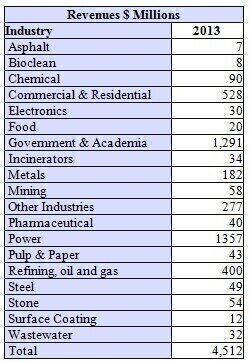Air Monitoring
Air Monitoring Market to Exceed $ Billions This Year
Jan 28 2013
The market for monitoring and instrumentation systems to measure the properties of gases including air will exceed $4.5 billion in 2013. This is the latest forecast in Air & Water Pollution Monitoring World Markets published by the McIlvaine Company (USA).
The market will achieve growth well above GDP because of five important factors: Increasingly stringent air pollution control regulations; The desire to increase energy efficiency and reduce fuel costs; Process automation and labour reduction; Product quality control and Increasing stringency of health and safety regulations
Developed and developing countries are all increasing the stringency of their air pollution regulations. Accurate measurement of the pollutants is the key to enforcement. With the steady increase in the cost of fuel and the negative aspects of carbon dioxide emissions, energy efficiency is becoming increasingly important. Instant measurement of the products of combustion and of oxygen is critical.
Process automation is often dependent on continuous monitoring of physical and chemical composition of gases. Refining, oil and gas exploration and petrochemical production rely on these measurements.
Product quality control is also enhanced by air measurement. Semiconductor chips are subject to particulate damage. Facility monitoring systems continuously measure particulate at many points.
The safety and health of workers and residents is leading to accelerated monitoring of work and living space. Air borne contaminants include particulates, gases, mould, viruses, etc.
All gas phase measurement devices are included.
The measurements can be made continuously in processes, with periodic sampling and in the laboratory. Some of the laboratory sampling is of solids or liquids which have been used to trap the air contaminants.
Devices are needed to measure the physical properties of the gas.
Measurement of chemical properties is a challenge. There are hundreds of gas phase compounds which need to be measured. Some contaminants e.g. dioxins, appear as a number of distinct compounds. It is, therefore, necessary to measure each and utilise an equivalency factor to measure the total for the contaminant group. The chemical groups can be divided into four categories: Compounds impacting combustion efficiency (oxygen, carbon monoxide, carbon dioxide); Pollutants in gas phase (SO2, NOx, Ammonia); Pollutants in particulate phase (cadmium, lead); Pollutants in aerosol phase (sulphuric acid mist)
The forecasts do not include devices measuring air and gas properties in vehicles. This is a large and separate market.
Digital Edition
IET 34.2 March 2024
April 2024
Gas Detection - Biogas batch fermentation system for laboratory use with automatic gas analysis in real time Water/Wastewater - Upcycling sensors for sustainable nature management - Prist...
View all digital editions
Events
Apr 30 2024 Melbourne, Australia
Apr 30 2024 Birmingham, UK
May 03 2024 Seoul, South Korea
May 05 2024 Seville, Spain
May 06 2024 Minneapolis, MN, USA


















